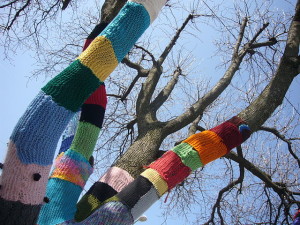In a previous column, I explored a bit of the what and why of creative placemaking. But what about the placemaking that’s happening here and now in Baltimore?
Earlier this summer, as I walked around Highlandtown with a group of friends, I stumbled upon two remarkable things…
The first was the Maryland Traditions Folklife Festival was wrapping up as we approached the Creative Alliance. The street was filled with music and smiling faces of all ages. Even though it wasn’t our destination, it was a kind of random joy, the sort you experience just from discovering the cool things going on in your city and the people enjoying them.
Further down the block, we discovered new benches and yarnbombed trees at the intersection of Conkling and Eastern. What had previously just been a street — fairly unremarkable — was now an inviting and creative space.
Both of these encounters touch upon the strength of creative placemaking: Spaces are transformed and, as a result, they pique your curiosity, invite you in and just plain make you notice them. For residents, the process not only improves your immediate area, it also forges a sense of place and identity.
The public space at Conkling and Eastern is one of the neighborhood improvements that’s come out of a creative placemaking workshop held last May by the Southeast Community Development Corporation, the Creative Alliance and Banner Neighborhoods and facilitated by Deborah Patterson of ARTblocks. The workshop involved a wide cross-section of the community, including residents and area merchants, and resulted in a list of short-term and long-term goals for the community and the Southeast CDC. Creative placemaking is just one of the tools the CDC is using to promote and improve the community, but it’s a significant one because it allows so many voices to be heard and for residents to not only benefit from, but also participate, in the process.
That focus on improvements generated and determined at a grassroots level is the work of Deborah Patterson and ARTblocks and is informed in the placemaking process developed by Project for Public Spaces. I admire the work Patterson is doing because, while the process is consistent (i.e., public workshops soliciting community opinion on issues and solutions), the end result is awesomely varied:
- A living chair in Druid Hill Park
- A ceramic mural in Pimlico
- A guerilla crosswalk in Hampden
- Elephants in Mondawmin (coming soon!)
- A mosaic mural on the facade of Westside Elementary (coming soon!)
- Story time at the Living Chair in Druid Hill Park
- Ceramic mural for Pimlico Road Arts & Community Center
- Elephants for Mondawmin
- ARTblocks mosaic workshop
Photos courtesy of Druid Hill Farmers Market (leftmost) and ARTblocks.
I also appreciate that ARTBlocks projects are happening all across the city, not confined only to designated arts districts. While I’m also excited for the developments in those areas (like the Bromo Tower crosswalks and Europe-Baltimore collaborative placemaking project Transit), I also applaud efforts by ARTblocks and The Baltimore Love Project to make all neighborhoods surprisingly and delightfully artful.
So much of what’s happening in Baltimore is relatively recent, so it’s difficult to quantify the impact of these projects. Next, I’ll be diving back into the numbers, though, and exploring the challenges of communicating the impact of creative placemaking.





